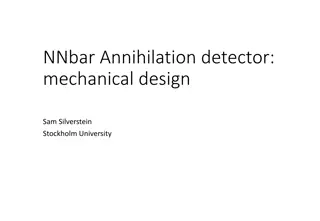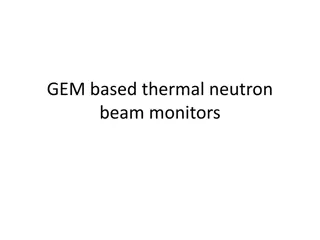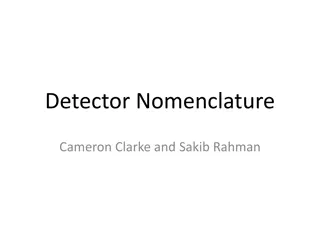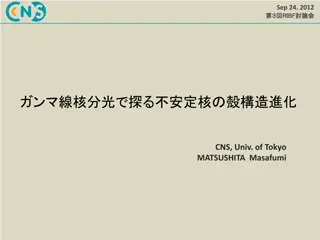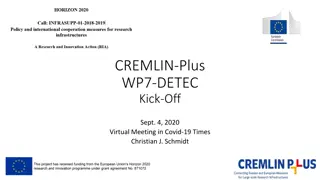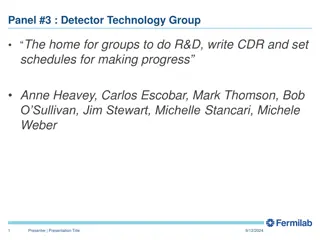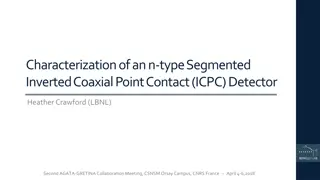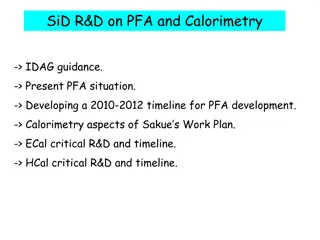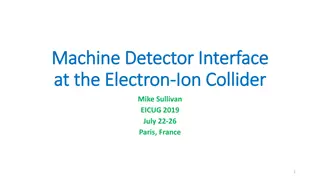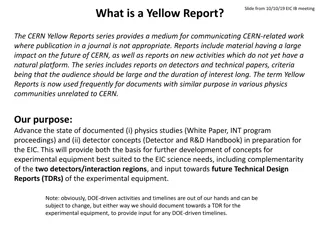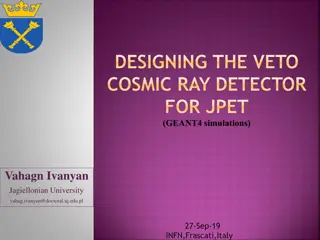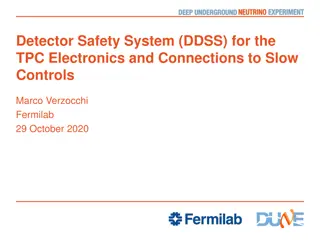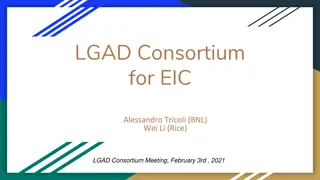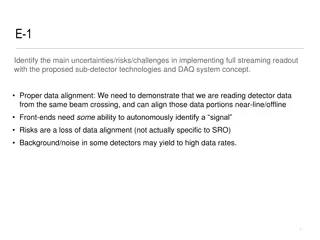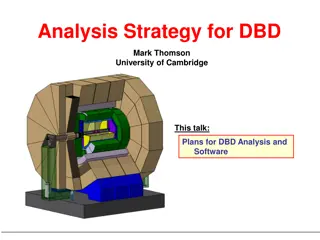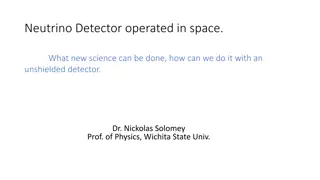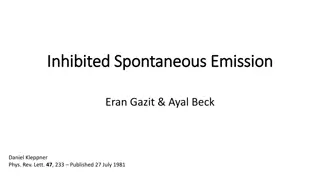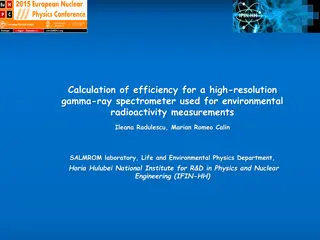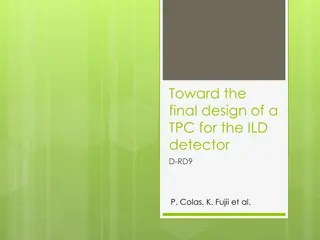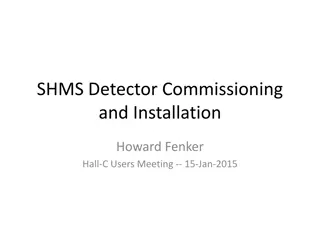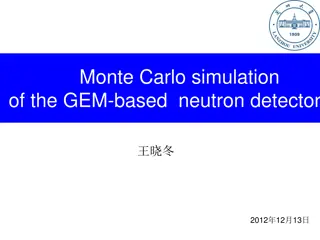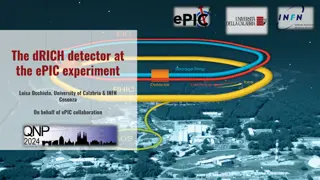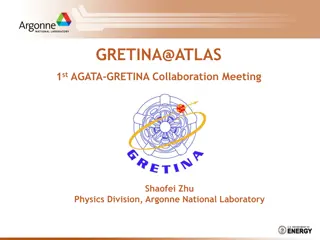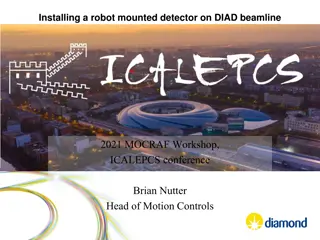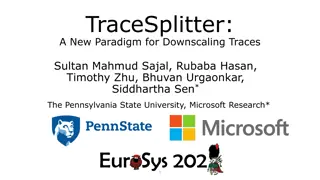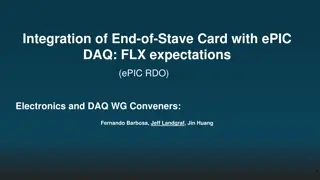ECFA Detector R&D Roadmap and International Collaborations Update
The ECFA Detector R&D Roadmap outlines collaborative efforts in particle physics research, focusing on high-field magnets, muon beams, and more. Task Forces are coordinating community consultations for future experimental programs, with a goal to fulfill strategic needs identified by the ESPP update
0 views • 28 slides
NNbar Annihilation Detector Mechanical Design Proposal
This proposal outlines the mechanical design considerations for the NNbar Annihilation Detector, highlighting practical concerns and proposed changes to the baseline design. Topics cover the structure support, component weights, installation challenges, and optimizations for improved detector perfor
2 views • 27 slides
Innovations in Pixel Detector Technology for Photon Science
Technologies and advancements in pixel detector development for photon science applications are showcased in this content. Topics discussed include balancing gain and dynamic range in hybrid pixel detectors, performance assessments of integrating pixel detectors, and strategies for photon detection
4 views • 21 slides
Innovative Solutions for Thermal Neutron Beam Monitoring
Cutting-edge detector solutions are proposed for thermal neutron beam monitoring, utilizing various configurations such as head-on bGEM with electronics, bGEM with side electronics, and side-on bGEM TPC-like setups. These solutions offer precise detection capabilities within specified envelope dimen
0 views • 7 slides
Advanced Detector Nomenclature and Proposed Segmentation System
This content provides detailed information on detector nomenclature, parts, and a proposed segmentation system for advanced spectrometers. It includes visuals and explanations of ring, septant, coil, and segment identification within the detector, offering insights into the intricate workings of spe
0 views • 4 slides
Advances in Nuclear Physics Research at RIKEN's RIBF Facility
Cutting-edge research at RIKEN's Radioactive Isotope Beam Factory (RIBF) in collaboration with the University of Tokyo, focusing on gamma-ray spectroscopy setups, in-beam experiments, and detector arrays like DALI2. The experiments involve studying reaction channels, Doppler shift effects, and explo
0 views • 20 slides
Understanding Electric Power Setups for Efficient RC Models
Exploring the components, advantages of brushless motors, importance of setup, key definitions, and a detailed process for selecting the right power setup for optimal performance in RC models. From estimating power needs to testing setups, this guide covers all aspects to enhance your flying experie
0 views • 26 slides
Closeout Report: Incremental Design Review of EIC Detector Electronics
Closeout report detailing the progress of the Incremental Preliminary Design and Safety Review of the EIC Detector DAQ and Electronics, along with the Final Design Review of Electronics Components for the ePIC Detector. The report includes responses to charge questions, panel reviews, comments, reco
0 views • 23 slides
Neutrino Detectors for NuStorm: Physics Goals and Detector Requirements
Physics goals for neutrino detectors in the NuStorm project include measuring exclusive neutrino cross sections, supporting long baseline programs, searching for sterile neutrinos, and improving measurements. Detector requirements involve reconstructing neutrino interactions, providing charge and pa
0 views • 21 slides
WP7-DETEC Kick-Off Meeting: Advancing Detector Technologies for Particle Physics
WP7-DETEC is a collaborative initiative focusing on the development of state-of-the-art detector technologies in the fields of nuclear physics and high-energy physics. The kick-off meeting aims to foster cooperation, exchange ideas, and educate young scientists in the field. Activities include sessi
0 views • 7 slides
Detector Technology Group: Research & Development Strategies
The Detector Technology Group focuses on R&D for detector technology, setting schedules to make progress. Discussions include short-term approaches for describing detectors, collaboration participation, and decision-making. Activities at CERN and Fermilab are reviewed to address any missing R&D area
0 views • 8 slides
Innovative n-Type Segmented Inverted Coaxial HPGe Detector Study
Comprehensive characterization of an n-type Segmented Inverted Coaxial Point Contact (ICPC) detector by Heather Crawford at the AGATA-GRETINA collaboration meeting. The study focuses on energy resolution, drift time corrections, azimuthal angle and full position reconstruction, along with in-beam ch
0 views • 29 slides
Development and Planning of PFA and Calorimetry in SiD R&D
The content discusses the research and development efforts related to Particle Flow Analysis (PFA) and Calorimetry, focusing on timelines, R&D guidance, and ongoing activities aimed at enhancing detector setups for realistic analysis. Efforts include algorithm optimization, validation, and collabora
0 views • 11 slides
Challenges and Considerations in Electron-Ion Collider Detector Development
Exploring the development of detector systems for Electron-Ion Colliders (EIC) involves addressing various issues such as detector acceptance for low Q2 and high Q2, unique beam characteristics, and the need for specialized components like bend magnets and polarimeters. Key considerations include po
0 views • 16 slides
Communication Strategies and Reports for Advancing Physics Studies and Detector Concepts at EIC
CERN Yellow Reports provide a platform for sharing impactful work related to CERN, including reports on detectors, technical papers, and new activities. The goal is to advance physics studies and detector concepts in preparation for the EIC, focusing on quantifying physics measurements, implications
0 views • 10 slides
Designing Veto Cosmic Ray Detector for JPET Using GEANT4 Simulations
Creating the Veto Cosmic Ray Detector for JPET involves designing the current version of Veto JPET, incorporating 42 scintillators, detecting 4 GeV cosmic muons, generating cosmic muon distribution, and simulating energy deposition inside the veto scintillators. The process includes particle generat
0 views • 26 slides
Arduino Circuit Challenges for Learning and Fun
Explore a series of challenges to build, program, and experiment with Arduino circuits, ranging from basic LED setups to utilizing sensors like LDR for advanced projects. Start with simple tasks and progress to more complex setups to enhance your knowledge and skills in electronics and programming.
0 views • 10 slides
Understanding Detector Response in SIDIS He3 Experiment
Introduction to analyzing hit and occupancy rates from different particle sources in the SIDIS He3 experiment. Explore the simulation data to determine event rates based on detector channels. Examples include pi0 sources and eDIS from the target. Various occupancy cuts are applied, and thresholds ar
0 views • 22 slides
SoLID Collaboration Meeting Summary - June 8th, 2020
Outline of the SoLID collaboration meeting discussing DAQ requirements, trigger rates, infrastructure, and R&D items. Details on detector layouts and triggers for PVDIS and SIDIS, with information on SoLID requirements and associated risks. SoLID DAQ overview based on 12 GeV FADC electronics. Discus
0 views • 35 slides
Detector Safety System (DDSS) for TPC Electronics and Connections to Slow Controls
The Detector Safety System (DDSS) for TPC Electronics involves multiple protection levels including slow controls, PLC-based systems, and fuses/diodes to ensure detector safety. It's crucial to consider these aspects during the design phase as modifications post-design are challenging. The system, d
0 views • 20 slides
LGAD Consortium for EIC: Advancing Detector Technologies
The LGAD Consortium aims to foster the development of detector technologies based on LGAD sensors for the Electron-Ion Collider (EIC) and future projects. By creating a collaborative effort, sharing expertise, and bringing together those interested in LGAD-based detectors, the consortium seeks to ad
0 views • 9 slides
Challenges and Common Solutions in Implementing Full Streaming Readout for Sub-Detector Technologies
Implementing full streaming readout with proposed sub-detector technologies and DAQ system concept poses challenges including proper data alignment, risks of data loss, and background noise affecting data rates. The transition point for electronic components from detector-specific to common solution
0 views • 9 slides
Development of Silicon Tracker and Sensor Technology for sPHENIX Detector
Research and development efforts are underway for silicon tracker and sensor technology to enhance the functionality of the sPHENIX detector. The project aims to improve mass resolution, cover specific areas effectively, and optimize sensor configurations. Various sensor concepts are being explored
0 views • 25 slides
Analysis Strategy for DBD by Mark Thomson - University of Cambridge
Mark Thomson from the University of Cambridge presented the analysis strategy for the Dual-Beta Detector (DBD) at the ILD Analysis Meeting in Paris, focusing on software models, reconstruction, and validation plans. The strategy includes goals to ensure required physics analyses, develop software mo
0 views • 11 slides
Exploring Neutrino Science in Space with Unshielded Detector - Opportunities and Innovations
The deployment of a neutrino detector in space presents a unique opportunity to conduct groundbreaking scientific research, leveraging the intense neutrino flux closer to the Sun. Key areas of focus include studying rare fusion neutrinos, observing neutrino oscillations during spacecraft transitions
0 views • 11 slides
Exploring Inhibited Spontaneous Emission in Physics
The study delves into inhibited spontaneous emission in physics, focusing on the phenomena, experimental setups, and effects like the Purcell effect. It discusses using waveguides and Rydberg atoms for this purpose, as well as the density of modes and states in free space and cavity configurations.
0 views • 16 slides
Efficiency Calculation of High-Resolution Gamma-Ray Spectrometer for Environmental Radioactivity Measurements
SALMROM laboratory at IFIN-HH conducts environmental radioactivity monitoring using high-resolution gamma-ray spectrometry. The system includes a Coaxial p-type HPGe detector with reliable traceability. Activities involve evaluating radon concentrations in various environments and assessing radionuc
0 views • 13 slides
Final Design of ILD Detector TPC - Towards Improved Performance
The final design of a Time Projection Chamber (TPC) for the ILD detector is detailed in this report, showcasing advancements made from 2007 to 2014. The project, D_RD9, focuses on addressing engineering challenges such as electronics, cooling, and software to enhance the TPC's feasibility and functi
0 views • 17 slides
SHMS Detector Commissioning and Installation Updates
Status updates on the commissioning and installation progress of the SHMS detector system, including the noble gas Cerenkov mount optics, mirrors, drift chambers, and various hodoscopes. Details on the system status, high voltage signal cables, DAQ, gas computing, and schedules for detector installa
0 views • 9 slides
Monte Carlo Simulation of GEM-Based Neutron Detector and Detector Performance Analysis
A detailed exploration of Monte Carlo simulations for GEM-based neutron detectors, investigating their detection efficiency and performance characteristics. Various detector designs and concepts, including multi-layer converters and GEM detectors, are discussed, along with simulation results on sign
0 views • 12 slides
Performance Studies of dRICH Detector at ePIC Experiment
The Electron-Ion Collider ePIC experiment focuses on the performance studies of the dRICH detector for particle identification crucial in various physics channels. The detector features aerogel optimization, SiPM sensors, and test-beam analyses. Key capabilities include different techniques for part
0 views • 28 slides
Advances in Nuclear Physics Research at AGATA-GRETINA Collaboration Meetings
Cutting-edge research opportunities in nuclear physics using sophisticated devices like GRETINA at ATLAS, focusing on Coulomb excitation, deep inelastic reactions, and transfer reactions for studying neutron-rich nuclei. The installation of GRETINA involves technical support, equipment upgrades, and
0 views • 20 slides
Installation of Robot-Mounted Detector on DIAD Beamline
Installing a robot-mounted detector on the DIAD beamline for the 2021 MOCRAF Workshop at the ICALEPCS conference. The robot arm holds a diffraction detector for dual imaging and diffraction purposes, ensuring safety for personnel, equipment, and integration into EPICS and GDA systems. Functionality
0 views • 28 slides
Overview of SiD Workshop Summary and DBD Planning
The SiD Workshop at the University of Oregon in November 2010 focused on the Summary of DBD Planning by Andy White. Key points covered included the timeline from Fall 2007 to End 2012, the Detailed Baseline Design DBD with nine crucial points, guidance for DBD presenters, and the importance of final
0 views • 29 slides
TraceSplitter: A New Paradigm for Downscaling Traces
This study introduces TraceSplitter, a novel approach for downscaling traces to run on smaller setups effectively. It discusses the need for downscaling in production and experimental setups, focusing on load balancing techniques. The paper compares prior approaches such as timespan scaling, average
0 views • 18 slides
Exploring High IOPS Applications and Server Configurations
Dive into the world of high IOPS applications, memory buffer configurations, and file server setups with a series of detailed images showcasing various server environments and code memory management. Discover the importance of optimizing IOPS for efficient data processing and explore advanced server
0 views • 16 slides
Integration of End-of-Stave Card with ePIC DAQ: FLX Expectations
In the realm of detector electronics, the integration of the End-of-Stave Card with ePIC DAQ is explored extensively through the FLX expectations set by the Electronics and DAQ Working Group. This integration involves various components such as the Global Timing Unit (GTU), Collider interfaces, Run
0 views • 10 slides
Performance of Scintillation Pixel Detectors with MPPC Read-Out and Digital Signal Processing
Mihael Makek presents the performance evaluation of scintillation pixel detectors with MPPC read-out and digital signal processing at the 2nd Jagiellonian Symposium on Fundamental and Applied Subatomic Physics in Krakow, 2017. The study includes the construction and testing of segmented detector arr
0 views • 25 slides
Organization and Setup Details for Green Bay Eye Seminar on February 10, 2018
Details for the Green Bay Eye Seminar on February 10, 2018, include requirements such as coat racks, garbage cans, tables for catering, and various setups in different areas like the Eagle Event Center and Lecture Hall SC130. Specific arrangements are needed for check-in, sponsor tables, catering se
0 views • 4 slides
The Role of Desktop Rentals in Temporary Office Setups
In this PPT, we explained about the role of desktop rentals in office setups. VRS Technologies LLC offers top-notch Desktop Rental Dubai services to help you stay productive. Explore our range of desktops perfect for short-term setups. Call 971-55-5
0 views • 8 slides

